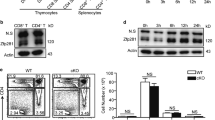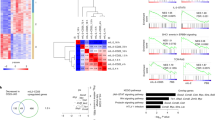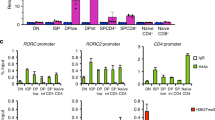Abstract
The balance of Th1 (eg, interleukin-2 (IL-2)) and Th2 (eg, IL-4) cytokines produced by CD4 T cells markedly influences the outcome of the adaptive immune response. Although octamer transcription factor proteins increase IL-2 transcription in T cells, their role in IL-4 gene transcription remains controversial. We have previously shown and now confirm that the proximal octamer binding site of the human IL-4 promoter, which separates the two most proximal NFAT binding sites, is bound prior to, but not after, activation in vivo. Since these two NFAT sites are essential for optimal IL-4 promoter activity, this suggested that prior engagement by octamer proteins might prevent adjacent NFAT binding and inhibit IL-4 gene transcription. In support of this hypothesis, here we show that NFAT proteins are unable to bind to a combined octamer/NFAT site unless the octamer proteins are competed away. Moreover, activity of an IL-4 reporter gene mutated in the proximal octamer binding site is increased compared to the wild-type promoter in human peripheral blood CD4 T cells. In addition, over-expression of either Oct-1 or Oct-2 decreased wild-type IL-4 promoter activity, while increasing IL-2 promoter activity. No decrease in promoter activity was seen when Oct-1 or Oct-2 was over-expressed with the octamer-mutant IL-4 reporter gene. Thus, octamer proteins are candidates to promote a Th1 rather than Th2 pattern of cytokine gene expression by activated CD4 T cells.
This is a preview of subscription content, access via your institution
Access options
Subscribe to this journal
Receive 6 digital issues and online access to articles
$119.00 per year
only $19.83 per issue
Buy this article
- Purchase on Springer Link
- Instant access to full article PDF
Prices may be subject to local taxes which are calculated during checkout
Similar content being viewed by others
References
Reiner SL, Locksley RM The regulation of immunity to Leishmania major Annu Rev Immunol 1995 13 151–177
Pardoll DM, Topalian SL The role of CD4+ T cell responses in antitumor immunity Curr Opin Immunol 1998 10 588–594
O’Garra A, Steinman L, Gijbels K CD4+ T-cell subsets in autoimmunity Curr Opin Immunol 1997 9 872–883
Glimcher LH, Murphy KM Lineage commitment in the immune system: the T helper lymphocyte grows up Genes Dev 2000 14 1693–1711
Lederer JA, Liou JS, Todd MD, Glimcher LH, Lichtman AH Regulation of cytokine gene expression in T helper subsets J Immunol 1994 152 77–86
Blanchard AD, Page KR, Watkin H et al Identification and characterization of SKAT-2, a novel Th2-specific zinc finger gene Eur J Immunol 2000 30 3100–3110
Berberich-Siebelt F, Klein-Hessling S, Hepping N et al C/EBPbeta enhances IL-4 but impairs IL-2 and IFN-gamma induction in T cells Eur J Immunol 2000 30 2576–2585
Gourley T, Roys S, Lukacs NW, Kunkel SL, Flavell RA, Chang CH A novel role for the major histocompatibility complex class II transactivator CIITA in the repression of IL-4 production Immunity 1999 10 377–386
Kimura M, Koseki Y, Yamashita M et al Regulation of Th2 cell differentiation by mel-18, a mammalian polycomb group gene Immunity 2001 15 275–287
Kamps MP, Corcoran L, LeBowitz JH, Baltimore D The promoter of the human interleukin-2 gene contains two octamer-binding sites and is partially activated by the expression of Oct-2 Mol Cell Biol 1990 10 5464–5472
Abe E, De Waal Malefyt R, Matsuda I, Arai K, Arai N An 11-base-pair DNA sequence motif apparently unique to the human interleukin 4 gene confers responsiveness to T-cell activation signals Proc Natl Acad Sci USA 1992 89 2864–2868
Cron RQ, Bort SJ, Wang Y, Brunvand MW, Lewis DB T cell priming enhances IL-4 gene expression by increasing nuclear factor of activated T cells J Immunol 1999 162 860–870
Pfeuffer I, Klein-Hessling S, Heinfling A et al Octamer factors exert a dual effect on the IL-2 and IL-4 promoters J Immunol 1994 153 5572–5585
Li-Weber M, Salgame P, Hu C et al Th2-specific protein/DNA interactions at the proximal nuclear factor-AT site contribute to the functional activity of the human IL-4 promoter J Immunol 1998 161 1380–1389
Li-Weber M, Giasi M, Krammer PH Involvement of Jun and Rel proteins in up-regulation of interleukin-4 gene activity by the T cell accessory molecule CD28 J Biol Chem 1998 273 32460–32466
Okamura H, Aramburu J, Garcia-Rodriguez C et al Concerted dephosphorylation of the transcription factor NFAT1 induces a conformational switch that regulates transcriptional activity Mol Cell 2000 6 539–550
Chen L, Glover JN, Hogan PG, Rao A, Harrison SC Structure of the DNA-binding domains for NFAT, Fos and Jun bound specifically to DNA Nature 1998 392 42–48
Klemm JD, Rould MA, Aurora R, Herr W, Pabo CO Crystal structure of the Oct-1 POU domain bound to an octamer site: DNA recognition with tethered DNA-binding modules Cell 1994 77 21–32
Mordvinov VA, Schwenger GT, Fournier R et al Binding of YY1 and Oct1 to a novel element that downregulates expression of IL-5 in human T cells J Allergy Clin Immunol 1999 103 1125–1135
Rooney JW, Hoey T, Glimcher LH Coordinate and cooperative roles for NF-AT and AP-1 in the regulation of the murine IL-4 gene Immunity 1995 2 473–483
Takemoto N, Koyano-Nakagawa N, Arai N, Arai K, Yokota T Four P-like elements are required for optimal transcription of the IL-4 gene: involvement of a distinct set of nuclear factor of activated T cells and activator protein-1 family proteins Int Immumol 1997 9 1329–1338
Tanaka M, Herr W Differential transcriptional activity by Oct-1 and Oct-2: interdependent activation domains induce Oct-2 phosphorylation Cell 1990 60 376–386
Liu Z, Latchman DS The octamer-binding proteins Oct-1 and Oct-2 repress the HIV long terminal repeat promoter and its transactivation by Tat Biochem J 1997 322 155–158
Li-Weber M, Salgame P, Hu C, Krammer PH Characterization of constitutive and inducible transcription factors binding to the P2 NF-AT site in the human interleukin-4 promoter Gene 1997 188 253–260
Wu GD, Lai EJ, Huang N, Wen X Oct-1 and CCAAT/enhancer-binding protein (C/EBP) bind to overlapping elements within the interleukin-8 promoter. The role of Oct-1 as a transcriptional repressor J Biol Chem 1997 272 2396–2403
Graef IA, Crabtree GR The transcriptional paradox: octamer factors and B and T cells Science 1997 277 193–194
Behre G, Smith LT, Tenen DG Use of a promoterless Renilla luciferase vector as an internal control plasmid for transient transfection assays of Ras-mediated transcription activation Biotechniques 1999 26 24–26, 28
Acknowledgements
The authors would like to thank Dr Winship Herr (Cold Spring Harbor Laboratory, New York) and Dr Anjana Rao (Harvard University, Cambridge, MA) for the generous gifts of octamer expression plasmids and anti-NFAT1 antisera, 67.1, respectively. We also thank Dr Terri Finkel (Children’s Hospital of Philadelphia, PA) for critical reading of the manuscript, Dr Kate Sullivan (Children’s Hospital of Philadelphia) for helpful advice, and Yunxia Wang and Anna Genin for technical assistance.
Author information
Authors and Affiliations
Corresponding author
Rights and permissions
About this article
Cite this article
Cron, R., Zhou, B., Brunvand, M. et al. Octamer proteins inhibit IL-4 gene transcription in normal human CD4 T cells . Genes Immun 2, 464–468 (2001). https://doi.org/10.1038/sj.gene.6363811
Received:
Revised:
Accepted:
Published:
Issue Date:
DOI: https://doi.org/10.1038/sj.gene.6363811
Keywords
This article is cited by
-
BOB.1/OBF.1 controls the balance of TH1 and TH2 immune responses
The EMBO Journal (2007)



